
Arthrodira is an order of extinct armored, jawed fishes of the class Placodermi that flourished in the Devonian period before their sudden extinction, surviving for about 50 million years and penetrating most marine ecological niches. Arthrodires were the largest and most diverse of all groups of placoderms.

Titanichthys is an extinct genus of giant, aberrant marine placoderm from shallow seas of the Late Devonian of Morocco, Eastern North America, and possibly Europe. Many of the species approached Dunkleosteus in size and build. Unlike its relative, however, the various species of Titanichthys had small, ineffective-looking mouth-plates that lacked a sharp cutting edge. It is assumed that Titanichthys was a filter feeder that used its capacious mouth to swallow or inhale schools of small, anchovy-like fish, or possibly krill-like zooplankton, and that the mouth-plates retained the prey while allowing the water to escape as it closed its mouth. A study has since confirmed this assumption as its jaws are functionally closer to that of filter feeders like baleen whales and basking sharks, and it appears to have developed from benthic durophagists that became pelagic suspension feeders. This would make it the first (known) large-sized vertebrate filter feeder. Titanichthys was estimated to have reached a length of 7–7.6 m (23–25 ft), but Engelman (2023) suggested that Titanichthys was comparable in size to Dunkleosteus, likely measuring about or just over 4.1 metres (13.5 ft) in length.
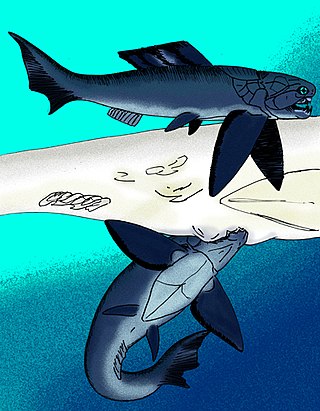
Dinichthys is an extinct monospecific genus of large marine arthrodire placoderm from the Late Devonian measuring around 3 metres (9.8 ft) long. Fossils were recovered from the Ohio Shale Formation along the Olentangy River in Delaware County, Ohio.

Arctolepis is an extinct genus of placoderm arthrodire fish which lived during the Early Devonian period. Fossils of Arctolepis have been found in what is now Norway and Michigan.

Phlyctaeniidae is an extinct family of placoderm arthrodire fishes that lived during the Devonian period, mainly in Norway and North America.

Dicksonosteus is an extinct genus of basal arthrodire placoderm fish which lived during the Early Devonian period of Spitsbergen, Norway.

Aleosteus is an extinct monospecific genus of arthrodire placoderm fish of the Early Devonian period. The type species Aleosteus eganensis was described in 2000, and was found in the Late Emsian strate of the Sevy Dolomite Formation, in the Egan Range of east-central Nevada, USA. Almost complete fossils belong to juvenile and adult specimens and show a short and broad skull, posteriorly concave.

Wuttagoonaspis is an extinct genus of primitive arthrodire placoderm fish from the Middle Devonian of Australia. The box-like skull is up to 18 centimeters in length, and the median dorsal plate averages in length about 10 centimeters. It contains two species: the type species Wuttagoonaspis fletcheri, described by Ritchie in 1973, and Wuttagoonaspis milligani, described by Young and Goujet in 2003.
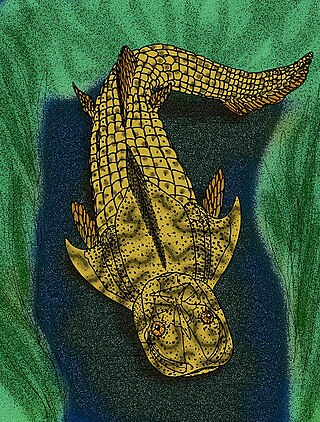
Yiminaspis is an extinct monospecific genus of primitive arthrodire placoderm fish from Emsian-aged marine strata in Yunnan, China. The type species Yiminaspis shenme was named and described in 2008, and is known from a flattened partial skull and portions of the thoracic armor.
Yujiangolepis is an extinct monospecific genus of arthrodire placoderm fish from the Pragian stage of the Devonian period. The type species is Yujiangolepis liujingensis, described from a single incomplete skull roof from the Nakaoling (Nagaoling) Formation of Hengxian, Guangxi, South China. It is one of the more basal members of the order Arthrodira, closely related to Antarctaspis, as shown in the cladogram below:
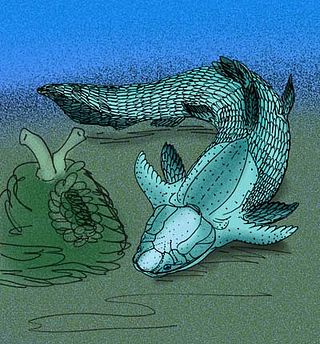
Antarctaspis is an extinct monospecific genus of arthrodire placoderm fish which existed in Antarctica during the Givetian age of the Devonian period. The type species Antarctaspis mcmurdoensis was described White in 1968, and is known from a partial head shield discovered in the Lashly Mountains of Antarctica. It is one of the more basal members of the order Arthrodira, closely related to Yujiangolepis, as shown in the cladogram below:
Aethaspis is an extinct genus of arthrodire placoderm fish from the Devonian period. Two species were described by Denison in 1958: Aethapsis major and Aethapsis utahensis. It is one of the more basal members of the order Arthrodira, as shown in the cladogram below:
Simblaspis is an extinct monospecific genus of arthrodire placoderm fish of the Early Devonian period. The type species Aleosteus eganensis was described in 1958, and was found in Pragian strata of the Qasr Limestone in Saudi Arabia.
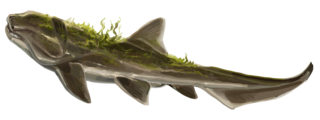
Heterosteus is an extinct genus of heterosteid placoderm of the Middle Devonian known from remains discovered in Europe and Greenland. According to Denison, 1978, Heterosteus might have been planktivorous, along with Homosteus, and Titanichthys.
Anarthraspis is an extinct genus of arthrodire placoderm fishes which lived during the Early Devonian period. It contains two species described in 1932, Anarthraspis chamberlini and Anarthraspis montanus, both found in the Beartooth Butte Formation of Wyoming and Montana, USA, and assigned to the genus in 1934.
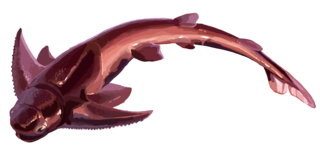
Kujdanowiaspis is an extinct genus of arthrodire placoderm fish from the Early Devonian of Podolia (Ukraine), Poland and Spain. Kujdanowiaspis is known from many fragmentary head shields and body armours.

Qataraspis is an extinct genus of primitive arthrodire placoderm from the Late? Devonian of Qatar. The type species is Q. deprofundis.
Erikaspis is an extinct monospecific genus of arthrodire placoderm fish found in Lochkovian-Pragian deposits of Podolia, Western Ukraine. The type species Erikaspis zychi was originally described in 1945 by Erik Stensiö based on a partial skull-roof, and was named Kujdanowiaspis zychi. In 2007, it was subsequently reassigned to the newly named genus Erikaspis, based on significant differences from Kujdanowiaspis.
Proaethaspis is an extinct monospecific genus of arthrodire placoderm fish from the Early Devonian period. The type species Proaethaspis ohioensis was described in 1960, but was assigned to the genus Proaethaspis in 1978.




















